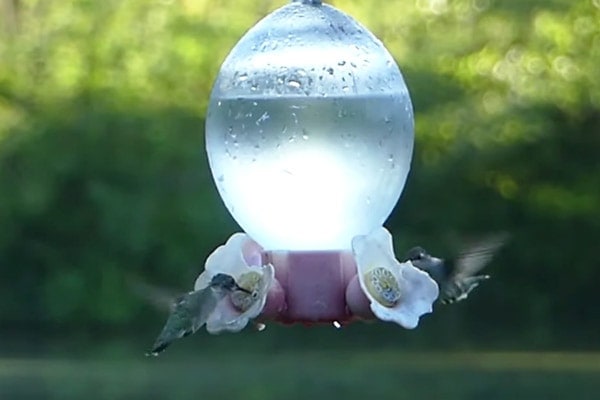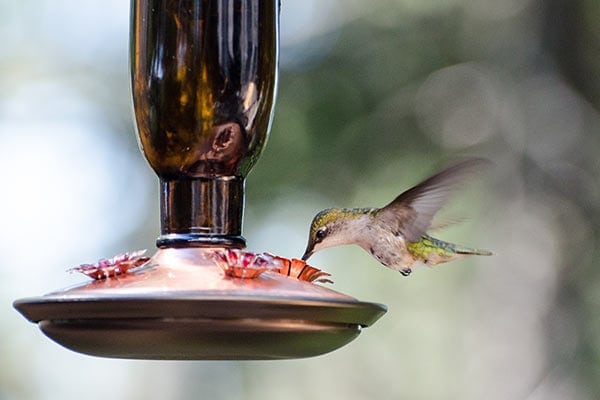Contents [show]
For bird-watchers and green thumbs alike, having a hummingbird visit your garden or feeder feels like a real win, even if you have coaxed them with bright feeders full of sugar water and flowers bursting with nectar.
It’s the ruby-throated hummingbird that typically visits my yard, and I’ve learned to watch and enjoy it because by the time I can take a picture – they’ve gone.
As delicate and enchanting as they are…
hummingbirds have a staggering level of endurance and, as a result, a voracious appetite.
To entice them to your colorful garden, you can hang a feeder nice and early in the spring and maybe plant some nectar-laden flowers. But do you want to know when to stop feeding hummingbirds? Keep reading to learn more.
Don’t Stop Feeding Hummingbirds

If you’re concerned about when to stop feeding the hummingbirds that visit your yard, the short answer is that there’s no need to stop offering them food.
Many hummingbird lovers are afraid that feeding them too long will interfere with natural instincts like migration.
Don’t worry that your nectar-filled feeder will override the hummingbird’s instinct to migrate: it won’t. Hummingbirds know to move on when the days get shorter, and the weather gets cooler. You do not need to remind them to migrate by removing their food.
Keep feeding your hummingbirds, especially in the fall. This is when they need the most nourishment, either before or during their migration south.
If you want to remove your feeder to protect it from winter weather or other animals, take it down when you haven’t seen a hummingbird for more than two full weeks. If you live in the States, this will likely happen in September.
Feeding Before Migration is Important

Different species of hummingbirds migrate to different areas, and this is the true test of their stamina.
If you drew a line right down the middle of the United States, the entire right side would be an accurate map of the spring migration of the ruby-throated hummingbird, by far the most commonly seen species.
Whereas other less common hummingbird species migration patterns show they favor the states and coast to the left of that line.
As early as March, gardens in the very southern States could start to see hummingbirds. Their spring migration to breeding grounds can take them right up into Canada’s southern parts between March and May.
That means, twice a year, these mighty little creatures fly nonstop for nearly 500 miles over the Gulf of Mexico before stopping to refuel. And before they take flight, they need to have gained up to 40% of their body weight in food to keep them going.
When Should You Start Feeding Hummingbirds?
You know why you should feed hummingbirds and that there’s no need to stop, but when should you start again if you decide to pause on feeding?
Your flower garden may not be in bloom yet, but you can boil sugar water and hang out your feeders. These feeders can also help keep them as regular visitors during the summer.
Where you live will determine how early you’ll see hummingbirds in your garden. As they travel during the day, if they’re going to stop by for a meal – it’ll likely be in the early morning or late afternoon.
Check out the spring migration routes and breeding ranges to know when they are likely to be in your area.
What Attracts Hummingbirds?
Hummingbirds come to your yard searching for food and can consume half their body weight in sugar every day. That’s equivalent to us eating 50-60 full-course meals. That’s a lot of food for something that weighs the same as two playing cards.
And the more food they can find in one visit to a garden, the more they’ll return.
But hummers will visit your garden for other reasons too.
In the dog days of summer, the water mist from a sprinkler will be an attractive bathing option for hummers, whose short legs usually keep them from joining in the birdbath fun.
Hummingbirds prefer to drink from moving water sources like fountains, as well as the fresh morning dew on leaves.
While they may steer clear of your beautifully-made birdhouse, hummingbirds may want to nest in sheltered shrubs or the low-lying branches of trees with easy access to nesting materials, like spiderwebs.
Providing Adequate Food Sources
There are several things you can do to help fill your visiting hummingbird’s belly.
Hang a Hummingbird Feeder with Sugar Water and Change it Regularly
To make the sugar water, boil1 cup of granulated sugar in 4 cups of boiling water. Let it cool and then pour into your feeder.
Hummingbirds are very territorial and will expend a lot of energy trying to keep others from their food source, so if you’re going to hang more than one feeder – spread them apart.
For more information about different feeders, check out these BirdInformer articles: Where to Hang a Hummingbird Feeder and Best Wild Bird Food: The Ultimate Buyer’s Guide To Selecting Great Food!
Plant a Variety of Brightly Colored Flowers
Who wouldn’t want to bury their beak in blooming sun-drenched flowers full of nectar? If you’re going to grow flowers that your hummer will sink into happily, keep to their favored color palette of red, pink, and orange.
The more tubular-shaped the flower, the more nectar it will hold. Try planting daylilies, foxglove, gladiolus, or my personal favorite – the snapdragon.
Don’t Spray for Insects
Spray from pesticides can blow and land on flowers, soaking your hummingbird’s food source with chemicals.
If hummingbirds are visiting, you likely won’t need to spray anyway, as hummingbirds can help keep the seasonal mosquito and fly invasion down. They’ve been known to snatch spiders from their webs and will gobble up gnats and even caterpillars.
Remember, our tiny hovering friends can starve if they don’t eat 5-8 times every hour, and hummingbirds cannot live on sugar alone; they also need protein from a delicious menu of bugs.
Keep Feeding Hummingbirds To Help Them Preserve Energy
Was Shakespeare talking about hummingbirds when he wrote, “though she be but little, she is fierce”? No, not at all. But it’s still apt!
Small but mighty, these intrepid birds work hard and rest frighteningly hard too. When working, their wings beat anywhere from 50 – 200 times a second, depending on whether they’re hovering, traveling, or diving.
When resting, their heartbeat slows, they may feel cold and overall look like they’ve moved on to hummingbird heaven.
As they are spending so much energy looking for food and then recovering from that search – do what you can to make it easier for them: move your feeder close to some tasty flowers to save them time and energy.
Final Thoughts
You might feel that you’re doing hummingbirds a favor by putting out a feeder topped up with delicious nectar, and in a sense – you are. You are saving them the time and energy of having to find another food source.
If you’re going to feed hummingbirds – then commit to feeding them throughout their breeding season. Be diligent about cleaning and restocking your feeder, keeping it far from threats and predators, and enjoy their lively and efficient visits.
Unsure of when to stop feeding hummingbirds? You can take a break, but you don’t have to stop completely. It’s important to remember that the sustenance you put out for hummingbirds will not override their migration instinct.
They need to eat, fatten up and refuel before their arduous migration south. No one wants to fly 500 miles on an empty stomach.
For more information about Hummingbirds, check out: Hummingbirds – Birdwatching, Facts, Hummingbird Birds – BirdInformer.com.
